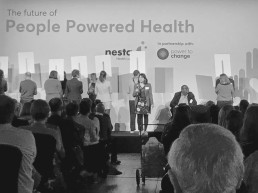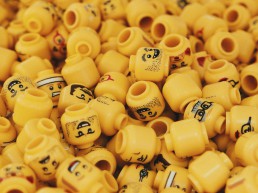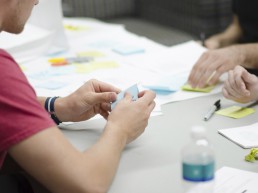I love it, but can you make it blue?
Where do ideas come from? Truly come from? The great ones, and even more so, the exceptional ones, are brought about through a need. A need to fill a gap, a frustration of something not working properly and wanting to make it better, to express something in a new and interesting way, or to overcome a problem that hasn’t been solved.
The journey to forming ideas can take you to some really exciting places that you never would have imagined from the outset. Whether I like blue or not, relate R&B to a form of sadistic torture or spend a large proportion of my time thinking about food is largely irrelevant in most cases. What matters are the thoughts, behaviours, and lives of the people your ideas need to make a difference to.
Ideas need to be brought to life and made great through interrogating the need. Understanding the root of the problem, the target audience and constraints, looking at it from every angle to ensure that whatever the solution, it is as robust, distilled and impactful as possible. This means, especially in the area of health, that it needs to be evidence based. Rooted in an understanding that makes the answer undeniably right and strong.
We recently developed some ideas for an engagement programme to empower a traditionally hard to reach community to take control of their health. One of the core initiatives we proposed was, on the surface and out of context, really random. I’ll admit it was an idea out of my comfort zone and something that wouldn’t interest me in the slightest. In fact, it’s the kind of thing that would make me feel uncomfortable and self-conscious. But then it wasn’t aimed at me. All of the research we conducted and insight we gathered suggested that this was a great way to reach this particular community and motivate them to act.
Being able to separate yourself from your predilections, to open and allow your mind to explore new ideas and ways of thinking based on strong and relevant insights, can really create incredibly powerful results.
If an idea is rooted in good insight, then it is hard to refute. If it truly solves the problem or need set out in the first place then personal tastes, feelings or opinions shouldn’t hold any weight. Subjectivity has no place here.
The illusion of balance
I doubt that anyone would disagree that a good work/life balance is a good thing, but seemingly this, for many, is only a theoretical aspiration. Why does this possibility go out the window when it comes to practice?
Why do so many people find themselves working crazy hours week in, week out, with no light at the end of the tunnel? And at what cost does this all-consuming element have on the rest of workers’ lives?
Seemingly gone are the days of a Monday to Friday 9-5 job. What is put down as core contracted hours are rarely achievable as companies expect more and more commitment from their staff, measured by time in the office. Even to the point where colleagues who leave on time are being marked down for doing so. Or asked if they are ‘doing a half day’. Instead of being congratulated for managing their time so effectively that they are able to do so. In many companies it is seen as the only way to move up the corporate ladder. Waiting until the boss has put their coat on and has one foot out the office door before feeling able to shut down and finally leave, whether they’ve had work to do or not. According to the TUC, workers in Briton in 2016 put in 2.1bn unpaid hours.
What kind of culture are we setting in the workplace when this is deemed the norm, or an expected way of working, and what kind of message does that give to our clients?
This is not helped by the continued cuts to employees, increasing the workload for the remaining few. Not only does this add exponential pressure, but increases the chance of people working in silos, unable to afford time to work collaboratively or support one another.
Given that companies still constantly talk about their staff being their most important asset, none of these actions indicates this to be true. There must be a better way. If work becomes a chore, and too pressured then people will start to resent it. Certainly within my own section of the industry, creativity is not something you can overly pressurise without expecting something to be compromised. The answers are not a one size fits all that can be turned on and off at will. People can’t function creatively 120% all the time. Something is going to give, either the quality of work, their passion and drive in the project or their health, both mentally and physically.
Anxiety, stress, depression or burn out are the only winners in these scenarios. People look after themselves less well through lack of sleep and because they are time poor, eating crap because their body needs quick fixes. Then they reward themselves at the end of the day with alcohol in order unwind and help them get to sleep, which will undoubtedly be poor sleep and so the cycle continues. Coupled with the fact that they have no work/life balance so cracks will start to show in relationships with partners, friends, and families who have been de-prioritised.
I realise that I am in danger of going off into a rant, if I’ve not done so already, but hopefully you’ll agree this is not wholly unfamiliar.
Now I’m not suggesting that we should do a complete 180 and everyone should be slacking off. Far from it, people can work incredibly hard in a concentrated amount of time, and from places other than the office. The time spent on something isn’t the same for the quality produced. The age-old quality, not quantity saying works to great effect here. Evidence suggests that productivity actually increases hour for hour if you work fewer hours overall. And if people are less stressed they are less likely to be off work.
Trust people more, give them more responsibility and ownership of the work they have been tasked with. They know the deadlines and when work needs to be reviewed and delivered. If we can’t even do that, why did we employ them in the first place? And if they don’t deliver, they are also clever enough to understand the consequences.
With the advancements of technology, the world is becoming much smaller with many more ways to connect to people. This enables us to work more remotely, on the move, more flexibly to enable juggling work and life to better effect, suited to the needs of the individual.
We need to embrace change and the possibilities now available to us, and use them to our advantage. By thinking of ways to do more with less, and without that meaning piling more pressure on already overworked staff, we can ensure that our most important assets are respected and treated fairly, and that the work produced will be the best it can be.
The Future of people powered health
Nesta’s six months of planning and development culminated last week into their slick ‘The Future of people powered health’ event, which didn’t disappoint. And it wasn’t just down to the inspirational and thought-provoking speakers, although they left the audience with a lot to think about. The day was enriched by multi-sensory feasts provided by innovators in health, with applications in stroke rehabilitation, custom fitted orthoses, and combating isolation, as well as a hauntingly beautiful orchestral composition by the New Note Orchestra as a form of focused addiction rehabilitation. If that wasn’t enough, it was punctuated by intelligent, passionate delegates with many different but relevant points of view; some of whom we were lucky enough to engage and debate with during the afternoon break-out sessions.
If only a solution to achieving a collaborative and supportive people-powered and data-driven health system, in a time of serious financial pressure, were as seamless and well constructed. Or indeed was decided and implemented by the like-minded experts from this event.
Unfortunately, there seems to be so many hurdles to overcome to achieve even a piece of this ideal, that for an individual it can feel overwhelming and paralysing. As a result, people feel powerless to effect any change at all, so do nothing. Hence nothing changes. Some people in the system even feel threatened by change – worried about it rather than embracing it and pushing the boundaries of possibility to create something new, relevant and stronger.
During the course of the day we heard from people who refused to think like that. People who are thick skinned enough to take the knock backs and get back up again to challenge and fight for what they truly believe in, even when hope has disappeared completely from view.
More than that, these driven and passionate innovators, pioneers if you will, understand their area of expertise through experience and listening from within their local community. Only from this well-informed position can we truly hope to understand a person’s needs rather than making assumptions and dictating solutions. We can then work together to find ways to solve the issues at hand.
They are also confident enough to make themselves vulnerable by not trying to make these changes alone in a silo, but by leaning on experts and experiences around them. Sharing their knowledge and collaborating in order to truly change behaviour and outcomes.
But how can we emulate these pockets of truly life changing projects? Should we even try Maybe a one size fits all approach is antiquated and wasteful in today’s society. Is it about understanding the essence of what these amazing teams are trying to achieve and being flexible and open enough to allow other projects to manifest themselves in different ways that best suit the communities that need them? Can we learn from, support and nurture similar innovations and harness the power of many, and make people feel invested in the future of health?
There are many interesting perspectives and proposals put forward surrounding this subject that we took away from the day, but we’d like to share two with you here. The first directly relates to the title of the event. In order to stop people feeling powerless to change, there needs to be a shift. The more balance of power we can have between people and healthcare professionals, the more invested people will be in their future health. Rather than dictating solutions, if these can be reached on a more equal footing there will be a greater understanding of why, strengthening both adherence of treatment for a diagnosis as well as reaching a diagnosis in the first place.
The second is around social prescribing. This is certainly very pertinent given the recent acquittal of the Belgian doctor who wrote his patient a sick note to get them out of a gym contract they couldn’t afford or use.
The restorative powers of social prescribing on well-being and future health can have exponential gains. Having an understanding of people’s lives and acting accordingly can unlock and rehabilitate in ways that drugs and surgery cannot, having a dual effect of relieving financial burden on our health service and time of HCPs, as well as benefiting the people in need of support and our most vulnerable. We should acknowledge the power social interaction can have on a person. Creating opportunities centred around a task or focus to give people’s lives, in many cases, more meaning and something to talk about. This can be taken a step further, in the right cases, by rehabilitating through the power of helping others to instill a sense of purpose and value.
Although everyone wants to ultimately solve the big problem of ‘people powered health’ and making our future health system workable, everyone can and needs to play their part, however small. The more people having meaningful conversations, listening, collaborating and challenging, the better. It’s amazing the ripple effect all this activity can have.
#peoplepoweredhealth #iseeu
Creativity shouldn’t be an afterthought
I had a really interesting conversation last week where I was pretty much told that what I am passionate about and do for a living is meaningless and doesn’t make a difference. On the surface I was, I’ll admit, rather taken aback. I needed to take a few moments to compose myself and construct a rational response to disprove this theory. What we did agree on is that if a creative solution isn’t grounded in solid insight and behavioural understanding to ensure its relevance, validity, and resonance, then it is unlikely to stand a chance of affecting maximum positive change. Also that this creative solution shouldn’t be limited to a list of old favourites; a video, logo, PPT, or A5 leave piece, but could be anything that best creatively solves the problem.
There is definitely room to pause here for a second to define what I mean when I talk about being creative. It is not the design or the copy alone, it is how everything that sits behind this is built to inform it, and link to how it is designed and written. To give a brand or product meaning requires an understanding much deeper, coupled with a universal belief and agreement by all parties involved to move in the same direction and act accordingly. I remember one of the hardest projects I ever had to do was when someone asked me to design a promotional leaflet, asking me to ‘make it look pretty’! I didn’t know where to start; who is the audience?, what is the key message?, what do we want them to do?, where are these leaflets going to be handed out or placed?
In order to achieve as much impact as possible, creativity needs to be considered much, much sooner than it usually. It should be integrated from the start to ensure everyone and everything is aligned and so that the ideas that are built off the back of the strategic approach are not rushed, are thought through and are robust enough to do all the initial hard work justice. It seems crazy that all of the upfront thinking is given weeks to build and develop, done in isolation away from the full team, and then when all of this great thinking needs to be developed into an idea and brought to life, the people tasked with doing so are hitting it cold. And they’re often hounded and rushed to execute it.
Creativity doesn’t start with copy and design, it starts with thinking differently, right from the start, about strategic and creative approaches to problems. Changing the antiquated habit of treating creativity as an end product will ensure that the results are more aligned, impactful and will make the differences that was hoped for at the beginning of the project.
Respecting the sum and its parts
You wouldn’t walk into an operating theatre, suggest to the surgeon that they might want to think about making that cut 4mm to the right, and offer to close the patient. Equally you wouldn’t bowl onto a building site laying bricks, ‘just because they look good there’ and all because you’ve seen and been in lots of houses. Human beings are generally good at respecting others’ expertise, so why is this so often not the case with graphic design? Do people not see this specialist area as an expertise?
Creativity benefits from like minds, collaborating and challenging one another in a constructive way. I certainly work better in this environment and believe that work is stronger and more robust as a consequence. No one, however, wants to be told how to do their job and disappointingly this happens more than I’d care to remember in the agency world. This tension between different parts of the internal team is usually due to poor communication (crazy right!) and can be incredibly damaging. If people aren’t working together towards a common goal or aren’t able to recognise and respect each other’s expertise, then the team isn’t working and the outputs will suffer.
This is why I believe it is so important to have the right team involved from the start, ensuring that we are all on the same page. Too often I have seen critical people missing from the initial stages of a project, citing that there is not enough budget to warrant so many people’s time. What undoubtably results is that more and more meetings are needed to unpick and solve problems further down the line, with more and more senior members included to try and get the work back on track. Ironically this results in spending more time and money than if all parties were invested in to begin with! Plus now with the added problem of having way too many cooks and too little time to complete the work with any aplomb.
All too often the root of the problem stems from not having agreed on, or written, a good enough brief. Now hang on a minute, before you groan with boredom and roll your eyes, just hear me out. If we as a united team; agency and client together, have defined and understood the problem, worked out a direction and plan to solve it together, then a lot of the friction later on can be avoided. By working together, embracing the restrictions and pressure points rather than fighting against them, we can ensure the output retains its strength and relevance and fulfils the initial need.
We have all spent time learning our respective craft, not because we wanted to be handed a list of instructions, but because we thrive on seeing good ideas come to life. We get a buzz out of using our expertise to create positive change and make a difference to people’s lives, and we all invest our precious time to achieve the outcomes we believe in. Quite simply, we need to have respect for, and see the value in, the expertise people bring to the table, and that only through collaboration and communication can truly great things happen. Once we believe this, we can finally build strong, bespoke, challenging, ‘fit for purpose’ teams that deliver truly exceptional work.




